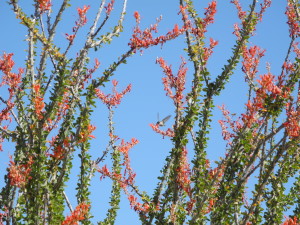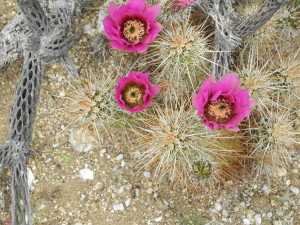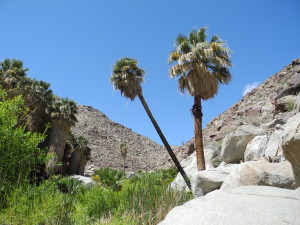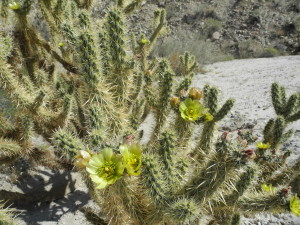Though hardly a household name outside its region, southern California’s Anza-Borrego Desert State Park is the Golden State’s largest, spanning some 600,000 acres of the Colorado Desert about two hours’ drive northeast of San Diego.
Anza-Borrego has rugged canyons, badlands, mesas, nature trails, campgrounds, oases, cacti gardens, Native American rock art, and wildlife, all surrounded by rugged mountain ranges, the latter of which are virtually all road-free wilderness areas.
My wife, Catharine, and I just spent several days there with friends from California — hiking, rock scrambling, seeking out springtime blossoms, four-wheel driving over sandy, bumpy “roads” leading to remote outposts of desert boulders and vegetation, and searching in vain for signs of desert bighorn sheep, the elusive animals that take to Anza-Borrego’s mountainous, rocky terrain. (“Borrego” is Spanish for bighorn sheep).
While we would have loved to have spotted some bighorns — one herd makes periodic appearances near the Palm Canyon Trail, the park’s most popular hike — we didn’t feel too bad about it. The park shelters somewhere between 250 and 600 of the iconic creatures, which means that each animal has an average of at least 1,000 acres in which to roam.
We did spot a roadrunner or two — or at least their tails as they zipped by — as well as the usual desert allotment of lizards, jackrabbits, and a wide array of birds, including hummingbirds in hog heaven gorging on the succulent spring nectars.
Vegetation on Parade
Anza-Borrego’s rich vegetation, which varies with the elevation, comes in a plethora of shapes and sizes: tall, stem-like ocotillos topped with bright red flowers; yellow-blossomed, green-branched palo verde trees; sharp-needled chollas; spiky-looking agave plants; rounded, spiny barrel cacti; appropriately shaped beavertail cacti; and pink-flowered hedgehog cacti among the most prominent. (You won’t find the well-known Saguaro cacti here — recognizable by their imposing height and signature arms; those grow in the Sonoran Desert of Arizona and northern Mexico).
Though we were there toward the end of spring blossoming season, there were still plenty of colorful blooms to admire, in shades of purple, yellow, red, pink, and white.
The Palm Canyon Trail, which leads from the campground near the Visitor’s Center, is easily the most accessible and well-marked trail in the park. While hikers of all ages managed to complete the three-mile round trip, it was not an easy stroll.
But it led to California’s third-largest palm oasis, featuring a number of distinctive California fan palms (native to the region) and a stream of cool water — welcome on a hot, dusty day — emerging from the mountains behind.
While camping is a popular activity, we opted for a hotel with swimming pool — a concession to our aging bodies — in the town of Borrego Springs, which lies in a valley adjacent to the park. Borrego Springs has plenty of Mexican (and a few other) restaurants, lodgings, and some wonderful public art sculptures that I’ll write about in my next post.
The “season” in Anza-Borrego runs pretty much from October through April, after which the searingly hot summer temperatures scare off most everyone but mad dogs, Englishmen, and visiting Germans, who seem to relish 125-degree heat.
So this is a good one to file and save for next year — especially spring — when the desert landscape comes alive with color once more.
Once the summer months appear, I’ll keep heading west toward San Diego and the California beaches. But then again, I’m not German.
















2 Responses to In Search of Desert Cacti, Blooms and Bighorns